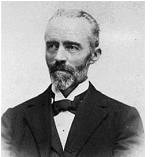December 2010 Newsletter: Theodore Kocher and His Nobel Prize

Theodore Kocher is known as the “father of thyroid surgery”. He was also the first surgeon to receive the Nobel Prize, which many have assumed was awarded for his having introduced the modern era of safe and effective thyroid surgery. This however was almost certainly not the case.
Theodor Kocher (1841-1917) was appointed to the Chair of Surgery in Berne, Switzerland in 1872. He was a skilled and innovative surgeon. He developed artery forceps to ligate major vessels and described the technique of “capsular dissection”, reducing the risk of haemorrhage, recurrent laryngeal nerve injury and hypoparathyroidism. This was in contrast to his contemporary, Theodor Billroth, Professor of Surgery in Vienna, who was considered a somewhat “rough” thyroid surgeon and who had a reportedly high incidence of permanent complications following thyroidectomy. When Kocher retired in 1917 he was able to report his entire series of 5,000 thyroidectomies with only 0.5% mortality, a truly remarkable achievement for the times. Kocher was also the first surgeon to receive a Nobel Prize (in Physiology or Medicine) in 1909. Many assume that the Nobel Prize was awarded in recognition of this significant contribution to safe surgical technique, however that is almost certainly not the reason for the award. The Nobel citation, read by Professor the Count KAH Morner in Stockholm in 1909, states: “Professor Kocher has given us a comprehensive exposition fundamental to our knowledge of this gland ......... through which it became quite clear that complete extirpation of the thyroid gland is reprehensible. A portion of the gland which is capable of functioning, must always be left behind at operation”. In other words, the Nobel Prize was specifically awarded for Kocher’s conclusion that a partial thyroidectomy, not total thyroidectomy, should be performed for benign goitre. Kocher did not arrive at that conclusion because of his concern about the risk of surgical complications – he was a superb technical surgeon. Rather the Nobel Prize was awarded in recognition of Kocher’s meticulous follow-up, representing one of the first ever surgical outcomes studies. Kocher recalled all his patients who had undergone thyroidectomy and was dismayed to find that almost all (89%) who had undergone a total thyroidectomy appeared small, ugly and cretinoid. At the time he attributed this to tracheal asphyxia due to loss of support of the trachea, and applied the term “cachexia strumipriva” . He was so saddened he determined never again to do a total thyroidectomy, and championed lobectomy for benign disease, adding contralateral arterial ligation for toxic goitre. This approach was adopted by thyroid surgeons worldwide many of whom visited Kocher in Switzerland. Despite the subsequent demonstration that the observed symptoms were due to thyroxine deficiency, and could be prevented by replacement therapy, subtotal thyroidectomy remained standard of care for benign for the next 100 years.
Wellbourn R. History of Endocrine Surgery. 1990. Praeger, NY













